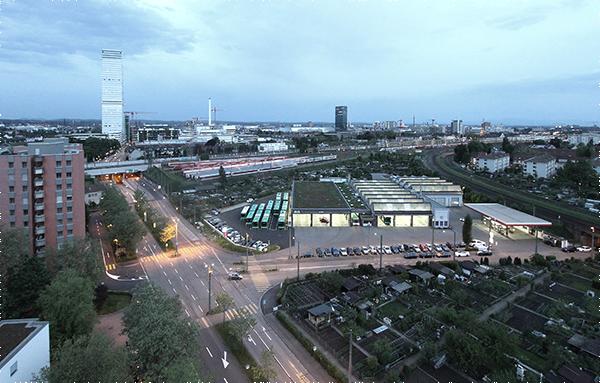Achtung: die Landschaft IV

Building on the Built: Basel East
The discovery of neglected sites within the city’s fabric represents the possibility for the transformation of an abandoned railway track into a pedestrian promenade that connects the eastern districts of Basel with the neighboring German agglomerations. Currently underused or abandoned sites along the tracks are transformed into housing for affordable living.
In his book, Entfaltung einer Planungsidee (1963), addressing the possibility of transforming the structure of the city, Ludwig Hilberseimer points out two possible options: the first concerns the city’s outward expansion and the second, the transformation of the city from within through the gradual modification of its existing elements. The latter, although often overlooked due to constraints normally associated with the city’s property structure and regulations, appears particularly relevant in relation to the current Swiss urban debate, as it represents a concrete answer to the on-going process of re-urbanization and the recommendation of the Federal Office for Spatial Development (ARE) for the centripetal growth of settlements. As there are practically no vacant urban sites in Basel and the population continues to expand, the official planning policy suggests densifications wherever possible within the current zoning plan. As these are mostly private properties, it is impossible to make a reliable future plan within these established neighborhoods.
In contrast, this proposal is based on the assumption that within the current fabric of the city, one can still find potential sites that lie outside of the official zoning, where new housing units can be accommodated. For this reason, the project started by exploring and observing the current city through extensive walks in a similar way to the Swiss sociologist Lucius Burckhardt’s “strollological” observations of the urban and suburban environment. During these walks, several potential sites have been discovered adjacent to a railway line owned by the German State that used to connect Weil am Rhein with Grenzach that has remained unused since 1997. The embankment on which the tracks are placed—built in the early 1900s in order to prevent the subdivision of the city and to allow for car and pedestrian mobility to continue uninterrupted below the train line—constitutes an unexpected urban element that, once highlighted on the map, emerges from the geometric pattern of the surrounding housing configurations. A series of other neglected areas along this railway line have been located. Of particular interest among these sites are the bus depot on Rankstrasse, various allotment-gardens, and a few infrastructural remnants.
In his well-known description of the terrain vague, the Spanish urban planner Ignasi de sola Morales writes about interior islands that have remained outside of the urban dynamic. According to de sola Morales, dealing with these parcels of land is inevitably problematic, as any design act could be seen as an aggressive instrument of power and abstract reason. In addition, densification is far from being a neutral act, especially when it concerns the upgrade of neglected sites. Along with urban renewal, the transformation of terrain vague has recently been identified as one of the triggers of urban gentrification. Although, thanks to the particularities of the local real estate market in Switzerland, the low proportion of property units and the present housing legislation, gentrification has been rather limited. The recent development of luxury residential units in central urban areas clearly represents the growing allure of central urban locations for the affluent.
In order to avoid potential urban and social risks, our approach focuses on sites that are not currently in the building zone and therefore beyond the realm of real estate mechanisms. As the land is mostly public in these cases, we suggest the development of new forms of affordable housing to be rented and managed by the city authorities.

PEOPLE: PROF. JACQUES HERZOG, PROF. PIERRE DE MEURON, CHARLOTTE VON MOOS, LISA EULER, MARTINO TATTARA, METAXIA MARKAKI

